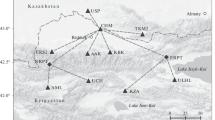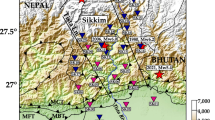Abstract
It has been two decades since the last comprehensive standard model of ambient earth noise was published Peterson (Observations and modelling of seismic background noise, US Geological Survey, open-file report 93–322, 1993). The PETERSON model was updated by analyzing the absolute quietest conditions for stations within the GSN (Berger et al. in J Geophys Res 109, 2005; Mcnamara and Buland in Bull Seism Soc Am 94:1517–1527, 2004; Ringler et al. in Seismol Res Lett 81(4) doi:10.1785/gssrl.81.4.605, 2010). Unfortunately, both the original model and the updated models did not include any deployed station in North Africa and Middle East, which reflects the noise levels within the desert environment of those regions. In this study, a survey was conducted to create a new seismic noise model from very broadband stations which recently deployed in North Africa. For this purpose, 1 year of continuous recording of seismic noise data of the Egyptian National Seismic Network (ENSN) was analyzed in order to create a new noise model. Seasonal and diurnal variations in noise spectra were recorded at each station. Moreover, we constructed a new noise model for each individual station. Finally, we obtained a new cumulative noise model for all the stations. We compared the new high-noise model (EHNM) and new low-noise model (ELNM) with both the high-noise model (NHNM) and low-noise model (NLNM) of Peterson (Observations and modelling of seismic background noise, US Geological Survey, open-file report 93–322, 1993). The obtained noise levels are considerably lower than low-noise model of Peterson (Observations and modelling of seismic background noise, US Geological Survey, open-file report 93–322, 1993) at ultra long period band (ULP band), but they are still below the high-noise model of Peterson (Observations and modelling of seismic background noise, US Geological Survey, open-file report 93–322, 1993). The results of this study could be considered as a first step to create permanent seismic noise models for North Africa and Middle East regions.




Similar content being viewed by others
References
Abd el-aal, A. K. (2012), Very broadband seismic background noise analysis of permanent good vaulted seismic stations. Journal of seismology, accepted, online first, doi:10.1007/s10950-012-9308-5.
Abd el-aal, A. K. (2011), Harmonic by harmonic removal technique for improving vibroseis data quality, Geophysical Prospecting, 2011, 59, 279–294, doi:10.1111/j.13652478.2010.00918.x.
Abd el-aal, A. K. (2010a), Eliminating upper harmonic noise in vibroseis data via numerical simulation, Geophys. J. Int. 181, 1499–1509, doi:10.1111/j.1365-246X.2010.04594.x.
Abd el-aal, A. K. (2010b), Modeling of seismic hazard at the northeastern part of greater Cairo metropolitan area, Egypt, J. Geophys Eng 7:75–90, doi:10.1088/1742-2132/7/1/007.
Abd el-aal, A. K. (2010c), Ground motion prediction from nearest seismogenic zones in and around Greater Cairo area, Egypt, Nat Hazards Earth Syst Sci 10:1495–1511, doi:10.5194/nhess-10-1495-2010.
Ahern, T. K., Buland, R. and Halbert, S. (1994), SEED format version 2.3 reference manual, IRIS, Washington, DC.
Berger, J., Davis, P. and Ekstrom, G. (2005), Ambient Earth noise: a survey of the global seismographic network, J. Geophys. Res., 109.
Brune, J. N. and Oliver, J. (1959), The seismic noise of the Earth’s surface, Bull. Seism.Soc. Am., 49, 349–353.
De Nisco, G. and Nunziata, C. (2011), VS profiles from noise cross correlation at local and small scale, Pure and appl. Geophys, volume 168, numbers 3–4, 509–520, doi:10.1007/s00024-010-0119-8.
Franti, G. E., Willis, D. E. and Wilson, J. T. (1962), The spectrum of seismic noise, Bull. Seism. Soc. Am., 52, 1, 113–121.
Given, H. K. (1990), Variations in broadband seismic noise at IRIS/IDA stations in the USSR with implications for event detection, Bull. Seism. Soc. Am. 80, 2072–2088.
Gurrola, H., Minster, J. B., Given, H., Vernon F., Berger, J. and Aster, R. (1990), Analysis of high frequency seismic noise in the western United States and eastern Kazakhstan, Bull. Seism. Soc. Am. 80, 951–970.
Mcnamara, D. E. and Buland, R. P. (2004), Ambient noise levels in the continental United States, Bull. Seism. Soc. Am. 94, 1517–1527.
Peterson, J. (1993), Observations and modelling of seismic background noise. US geological Survey, open-file report 93–322.
Ringler, A. T., Gee, L. S., Hutt, C. R. and Mcnamara, D. E. (2010), Temporal variations in global seismic station ambient noise power levels. Seismological Research Letters, v. 81, no 4, doi:10.1785/gssrl.81.4.605.
Rodgers, P. W., Taylor, S. R. and Nakanishi, K. K. (1987), System and site noise in the regional seismic test network from 0.1 to 20 Hz, Bull. Seism. Soc. Am. 77, 663–678.
Romanowicz, B., Stakes, D., Montagner, J. P., Tarits, P., Uhrhammer, R., Begnaud, M., Stutzmann, E., Pasyanos, M., Karczewski, J.F., and Etchemendy, S. (1998), MOISE: a pilot experiment towards long term seafloor geophysical observatories, Earth Planets Space, 50, 927–937.
Romanowicz, B., Stakes, D., Uhrhammer, R., Mcgill, P., Neuhauser, D., Ramirez, T. and Dolenc, D. (2003), The MOBB experiment: a prototype permanent offshore ocean bottom broadband station, Eos, Trans. Am. Geophys. Un., 84, 325–332.
Uhrhammer, R. A. (2000), Background noise PSD analysis of USNSN broadband data for 1998, Berkeley Seismological Laboratory report, 22 pp.
Welch, P. (1967), The use of fast Fourier transform for the estimation of power spectra: a method based on time averaging over short, modified periodograms, IEEE Trans. Audio Electroacoustics AU15, 70–73.
Young, C. J., Chael, E. P., Withers, M. M. and Aster, R. C. (1996), A comparison of high frequency (_1 Hz) surface and subsurface noise environment at three sites in the United States, Bull. Seism. Soc. Am. 86, 1516–1528.
Acknowledgments
The authors are grateful to the National Research Institute of Astronomy and Geophysics (NRIAG), Egyptian national seismological network Egypt for the provision of seismic data as well as all other facilities required for this research. Thanks are due to Dr. Hamid Nofel (Egyptian National Seismological Network) for kindly offering some power spectral density analysis codes and valuable advice during work in this research. Grateful thanks to Professor Rashad. M. Kebeasy (Egyptian National Seismological Network) who helped improve and edit the manuscript. Great thanks due to the reviewer Professor McNamara for his great recommendations which significantly improved the final version of the article.
Author information
Authors and Affiliations
Corresponding author
Rights and permissions
About this article
Cite this article
Abd el-aal, A.ea.K., Soliman, M.S. New Seismic Noise Models Obtained Using Very Broadband Stations. Pure Appl. Geophys. 170, 1849–1857 (2013). https://doi.org/10.1007/s00024-013-0640-7
Received:
Revised:
Accepted:
Published:
Issue Date:
DOI: https://doi.org/10.1007/s00024-013-0640-7




